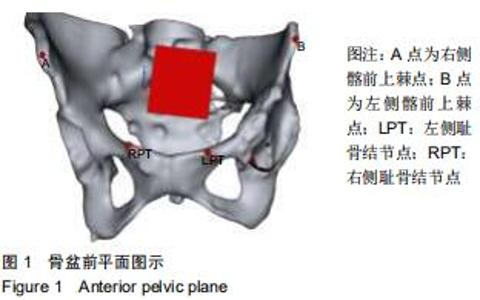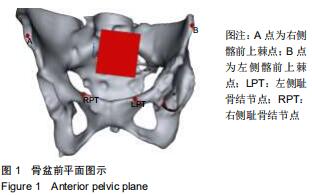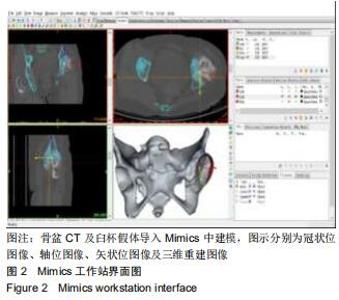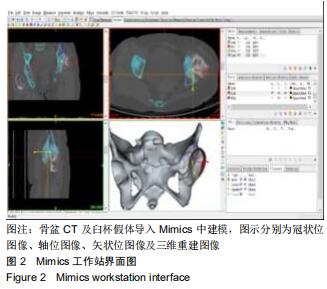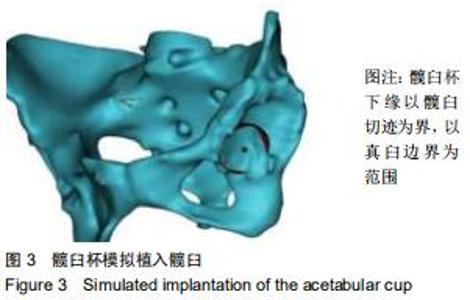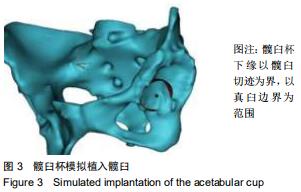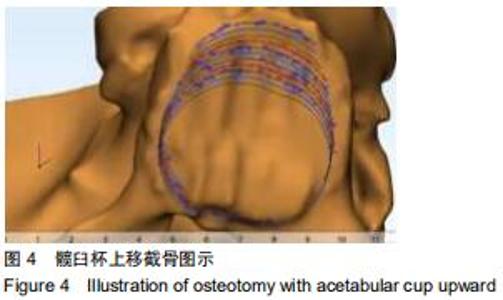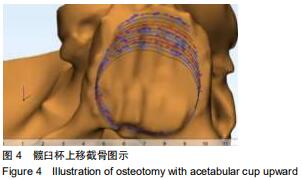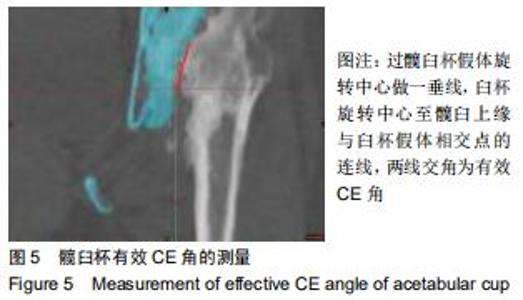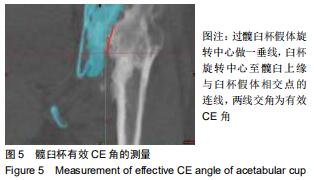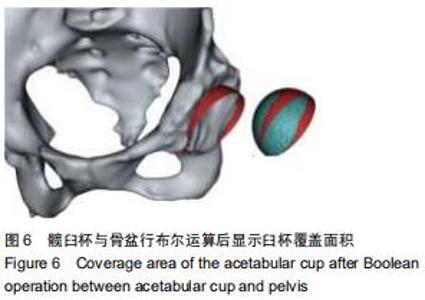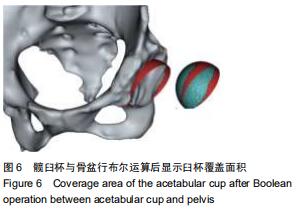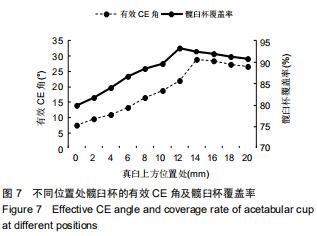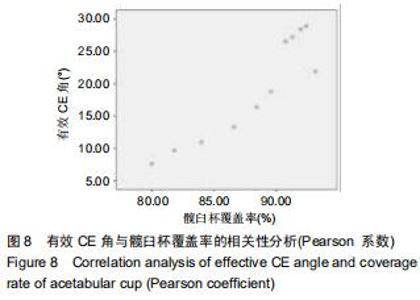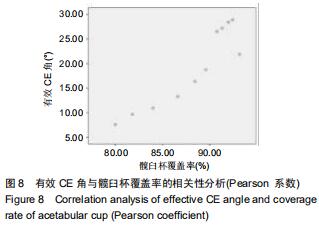Chinese Journal of Tissue Engineering Research ›› 2020, Vol. 24 ›› Issue (33): 5289-5294.doi: 10.3969/j.issn.2095-4344.2340
Previous Articles Next Articles
Stability of the acetabular cup in different positions to repair acetabular dysplasia
Zhao Yang, Chen Shirong
Department of Orthopedics, Second Affiliated Hospital of Chongqing Medical University, Chongqing 400010, China
-
Received:2020-02-10Revised:2020-02-20Accepted:2020-03-14Online:2020-11-28Published:2020-09-29 -
Contact:Chen Shirong, Chief physician, Department of Orthopedics, Second Affiliated Hospital of Chongqing Medical University, Chongqing 400010, China -
About author:Zhao Yang, Master candidate, Physician, Department of Orthopedics, Second Affiliated Hospital of Chongqing Medical University, Chongqing 400010, China
CLC Number:
Cite this article
Zhao Yang, Chen Shirong. Stability of the acetabular cup in different positions to repair acetabular dysplasia[J]. Chinese Journal of Tissue Engineering Research, 2020, 24(33): 5289-5294.
share this article
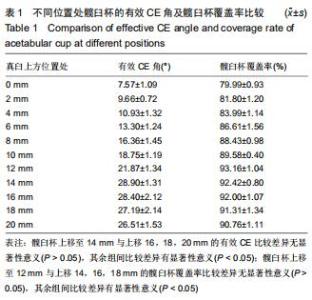
当髋臼杯上移至14 mm处时,此时测得的有效CE角最大,为(28.90±1.31)°,此时对应髋臼杯的直径为(42.00± 1.94) mm,与上移16,18,20 mm处测得的有效CE值比较差异无显著性意义(P > 0.05),其余组间比较差异有显著性意义(P < 0.05);当髋臼杯上移至12 mm时,此时测得的髋臼杯覆盖率最大,为(93.16±1.04)%,此时对应的髋臼杯直径为(43.00±1.73) mm,与上移14,16,18 mm处测得的髋臼杯覆盖率比较差异无显著性意义(P > 0.05),其余组间比较差异有显著性意义(P < 0.05),见表1。此次模拟中,所用臼杯最大为44 mm,最小为36 mm。在不采取自体骨移植的情况下,于真臼处测得的髋臼杯覆盖率值及有效CE角为最小值。 "
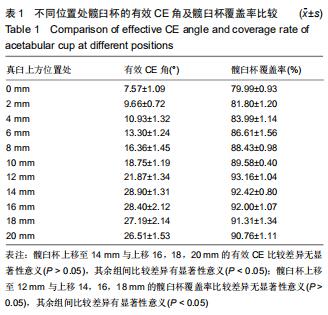
|
[1] HARRIS WH. Etiology of osteoarthritis of the hip.Clin Orthop and Relat Res.1986;21(3):20-23.
[2] HARTOFILAKIDIS G, STAMOS K, KARACHALIOS T, et al. Congenital hip disease in adults Classification of acetabular deficiencies and operative treatment with acetabuloplasty combined with total hip arthroplasty.J Bone Joint Surg Am. 1996;78(5):683-692.
[3] CROWE JF, MANI VJ, RANAWAT CS. Total hip replacement in congenital dislocation and dysplasia of the hip.J Bone Joint Surg Am.1979;61(1):15-23.
[4] ZHANG H, ZHOU JS, GUAN JZ, et al. How to restore rotation center in total hip arthroplasty for developmental dysplasia of the hip by recognizing the pathomorphology of acetabulum and Harris fossa?.J Orthop Surg Res.2019;14(1):1-8.
[5] PAGNANO MW, HANSSEN AD, LEWALLEN DG, et al. The effect of superior placement of the acetabular component on the rate of loosening after total hip arthroplasty.J Bone Joint Surg Am.1996;78(7):1004-1014.
[6] DANDACHLI W, NAKHLA A, IRANPEUR F, et al. Can the acetabular position be derived from apelvic frame of reference?Clin Orthop Relat Res.2009;467(4):886-893.
[7] CAMERON HU, EREN OT, SOLOMON M. Nerve injury in the prosthetic management of the dysplastic hip.Orthopedics. 1998;21(9):980-981.
[8] KANEUJI A, SUGIMORI T, ICHISEKI T, et al. Minimum ten-year results of a porous acetabular component for Crowe I to III hip dysplasia using an elevated hip cecnter.J Arthroplasty. 2009;24(2):187-194.
[9] MURAYAMA T, OHMISHI H, OKABE S, et al. 15-year comparison of cementless total hip arthroplasty with anatomical or high cup placement for Crowe I to III hip dysplasia.Orthopedics.2012;35(3):313-318.
[10] NAWABI DH, MEFTAH M, NAM D, et al. Durable fixation achieved with medialized, high hip center cementless THAs for Crowe II and III dysplasia.Clin Orthop Relat Res. 2014; 472(2):630-636.
[11] DIGIOIA AM, HAFEZ MA, JARAMAZ B, et al. Functional pelvic orientation measured from lateral standing and sitting radiographs.Clin Orthop Relat Res.2006;45(3):272-276.
[12] SARIALI E, BOUKHELIFA N, CATONNE Y, et al. Comparison of Three-Dimensional Planning-Assisted and Conventional Acetabular Cup Positioning in Total Hip Arthroplasty: A Randomized Controlled Trial.J Bone Joint Surg Am. 2016; 98(2):108-116.
[13] VANDENBUSSCHE E, SAFFARINI M, TAILLIEU F, et al. The asymmetric prfile of the acetabulum.Clin Orthop Relat Res. 2008;466(2):417-423.
[14] SCHUTZER SF, HARRIS WH. High placement of porous-coated acetabular components in complex total hip arthroplasty.J Arthroplasty.1994;9(4):359-367.
[15] FUKUI K, KANEUJI A, SUGIMORI T, et al. How far above the true anatomic position can the acetabular cup be placed in total hip arthroplasty? Hip Int.2013;23(2):129-134.
[16] XU J, XU C, MAO Y, et al. Posterosuperior placement of a standard-sized cup at the true acetabulum in acetabular reconstruction of developmental dysplasia of the Hip with high dislocation.J Arthroplasty.2016;31(6):1233-1239.
[17] ZAHAR A, PAPIK K, LAKATOS J, et al. Total hip arthroplasty with acetabular reconstruction using a bulk autograft for patients with developmental dysplasia of the hip results in high loosening rates at mid-term follow-up.Int Orthop. 2014; 38(5):947-951.
[18] GERBER SD, HARRIS WH. Femoral head autografting to augment acetabular deficiency in patients requiring total hip replacement. A minimum five-year and an average seven-year follow-up study.J Bone Joint Surg Am. 1986;68(8): 1241-1248.
[19] MULROY RD, HARRIS WH. Failure of acetabular autogenous grafts in total hip arthroplasty.Increasing incidence:a follow-up note.J Bone Joint Surg Am.1986;72(10): 1536-1540.
[20] ENER N, REMZI T, AK M. Femoral shortening and cementless arthroplasty in high congenital dislocation of the hip. J Arthroplasty.2002;17(1):41-48. [21] HARTOFILAKIDIS G, STAMOS K, KARACHALIOS T. Treatment of high dislocation of the hip in adults with total hip arthroplasty.Operative technique and long-term clinical results. J Bone Joint Surg Am.1998;80(4):510e7.
[22] XU JW, XU C, MAO YQ, et al. Posterosuperior placement of standard-sized cup at the true acetabulum in acetabular reconstruction of developmental dysplasia of the hip with high dislocation. J Arthroplasty.2016;31(6):1233e9.
[23] KOMIYAMA K, FUKUSHI JI, MOTOMURA G, et al. Does high hip centre affect dislocation after total hip arthroplasty for developmental dysplasia of the hip?. Int Orthop.2019;43(9): 2057-2063.
[24] TRAINA F, DE FM, BIONDI F, et al. The influence of the centre of rotation on implant survival using a modular stem hip prosthesis.Int Orthop.2009;33(6):1513-1518.
[25] TRAINA F, DE FM, TASSINARI E, et al. Modular neck prostheses in DDH patients: 11-year results.J Orthop Sci. 2011;16(1):14-20.
[26] BARTZ RL, NOBEL PC, KADAKIA NR, et al. The effect of femoral component head size on posterior dislocation of the artificial hip joint.J Bone Joint Surg Am. 2000;82(9): 1300-1307.
[27] COOPER HJ, DELLA VALLE CJ. Large diameter femoral heads is bigger always better?. Bone Joint J. 2014;96-B(11 Suppl A):23-26.
[28] KOHNO Y, NAKASHIMA Y, FUJII M, et al. Acetabular retroversion in dysplastic hips is associated with decreased 3D femoral head coverage independently from lateral center-edge angle.Arch Orthop Trauma Surg. 2019. doi:10.1007/s00402-019-03277-6.
[29] MAHIEU P, HANANOUCHI T, WATANABE N, et al. Morphological abnormalities of the femur in the dysplastic hip. Relation between femur en acetabulum.Acta Orthop Belg. 2018;84(3):307-315.
[30] ROGERS BA, GARBEDIAN S, KUCHINAD RA, et al. Total hip arthroplasty for adult hip dysplasia.J Bone Joint Surg Am. 2012;94(19):1809-1821.
[31] YANG YH, ZUO JL, LIU T, et al. Morphological Analysis of True Acetabulum in Hip Dysplasia (Crowe Classes I-IV) Via 3-D Implantation Simulation.J Bone Joint Surg Am. 2017; 99(17):e92.
[32] TSUTSUI T, GOTO T, WADA K, et al. Efficacy of a computed tomographybased navigation system for placement of the acetabular component in total hip arthroplasty for developmental dysplasia of the hip.J Orthop Surg Res. 2017; 25(3):1-7. [33] BAGARIA V, DESHPANDE S, RASALKAR DD, et al. Use of rapid prototyping and three- dimensional Reconstruction modeling in the management of complex fractures.Eur J Radiol.2011;80(3):814-820. |
| [1] | Min Youjiang, Yao Haihua, Sun Jie, Zhou Xuan, Yu Hang, Sun Qianpu, Hong Ensi. Effect of “three-tong acupuncture” on brain function of patients with spinal cord injury based on magnetic resonance technology [J]. Chinese Journal of Tissue Engineering Research, 2021, 25(在线): 1-8. |
| [2] | Hu Kai, Qiao Xiaohong, Zhang Yonghong, Wang Dong, Qin Sihe. Treatment of displaced intra-articular calcaneal fractures with cannulated screws and plates: a meta-analysis of 15 randomized controlled trials [J]. Chinese Journal of Tissue Engineering Research, 2021, 25(9): 1465-1470. |
| [3] | Huang Dengcheng, Wang Zhike, Cao Xuewei. Comparison of the short-term efficacy of extracorporeal shock wave therapy for middle-aged and elderly knee osteoarthritis: a meta-analysis [J]. Chinese Journal of Tissue Engineering Research, 2021, 25(9): 1471-1476. |
| [4] | Xu Feng, Kang Hui, Wei Tanjun, Xi Jintao. Biomechanical analysis of different fixation methods of pedicle screws for thoracolumbar fracture [J]. Chinese Journal of Tissue Engineering Research, 2021, 25(9): 1313-1317. |
| [5] | Jiang Yong, Luo Yi, Ding Yongli, Zhou Yong, Min Li, Tang Fan, Zhang Wenli, Duan Hong, Tu Chongqi. Von Mises stress on the influence of pelvic stability by precise sacral resection and clinical validation [J]. Chinese Journal of Tissue Engineering Research, 2021, 25(9): 1318-1323. |
| [6] | Lu Dezhi, Mei Zhao, Li Xianglei, Wang Caiping, Sun Xin, Wang Xiaowen, Wang Jinwu. Digital design and effect evaluation of three-dimensional printing scoliosis orthosis [J]. Chinese Journal of Tissue Engineering Research, 2021, 25(9): 1329-1334. |
| [7] | Zhang Tongtong, Wang Zhonghua, Wen Jie, Song Yuxin, Liu Lin. Application of three-dimensional printing model in surgical resection and reconstruction of cervical tumor [J]. Chinese Journal of Tissue Engineering Research, 2021, 25(9): 1335-1339. |
| [8] | Zhang Yu, Tian Shaoqi, Zeng Guobo, Hu Chuan. Risk factors for myocardial infarction following primary total joint arthroplasty [J]. Chinese Journal of Tissue Engineering Research, 2021, 25(9): 1340-1345. |
| [9] | Wei Wei, Li Jian, Huang Linhai, Lan Mindong, Lu Xianwei, Huang Shaodong. Factors affecting fall fear in the first movement of elderly patients after total knee or hip arthroplasty [J]. Chinese Journal of Tissue Engineering Research, 2021, 25(9): 1351-1355. |
| [10] | Wang Jinjun, Deng Zengfa, Liu Kang, He Zhiyong, Yu Xinping, Liang Jianji, Li Chen, Guo Zhouyang. Hemostatic effect and safety of intravenous drip of tranexamic acid combined with topical application of cocktail containing tranexamic acid in total knee arthroplasty [J]. Chinese Journal of Tissue Engineering Research, 2021, 25(9): 1356-1361. |
| [11] | Xiao Guoqing, Liu Xuanze, Yan Yuhao, Zhong Xihong. Influencing factors of knee flexion limitation after total knee arthroplasty with posterior stabilized prostheses [J]. Chinese Journal of Tissue Engineering Research, 2021, 25(9): 1362-1367. |
| [12] | Huang Zexiao, Yang Mei, Lin Shiwei, He Heyu. Correlation between the level of serum n-3 polyunsaturated fatty acids and quadriceps weakness in the early stage after total knee arthroplasty [J]. Chinese Journal of Tissue Engineering Research, 2021, 25(9): 1375-1380. |
| [13] | Zhang Chong, Liu Zhiang, Yao Shuaihui, Gao Junsheng, Jiang Yan, Zhang Lu. Safety and effectiveness of topical application of tranexamic acid to reduce drainage of elderly femoral neck fractures after total hip arthroplasty [J]. Chinese Journal of Tissue Engineering Research, 2021, 25(9): 1381-1386. |
| [14] | Wang Haiying, Lü Bing, Li Hui, Wang Shunyi. Posterior lumbar interbody fusion for degenerative lumbar spondylolisthesis: prediction of functional prognosis of patients based on spinopelvic parameters [J]. Chinese Journal of Tissue Engineering Research, 2021, 25(9): 1393-1397. |
| [15] | Lü Zhen, Bai Jinzhu. A prospective study on the application of staged lumbar motion chain rehabilitation based on McKenzie’s technique after lumbar percutaneous transforaminal endoscopic discectomy [J]. Chinese Journal of Tissue Engineering Research, 2021, 25(9): 1398-1403. |
| Viewed | ||||||
|
Full text |
|
|||||
|
Abstract |
|
|||||
